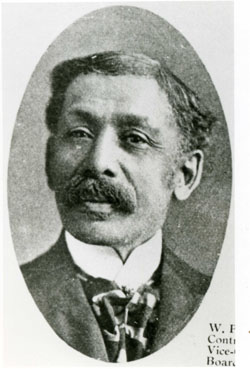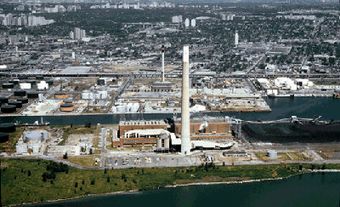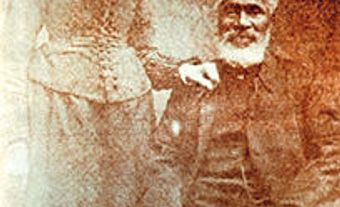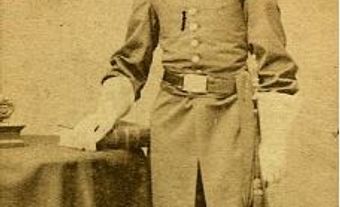William Peyton Hubbard, politician, inventor, baker, coachman (born 27 January 1842 in Toronto, ON; died 30 April 1935 in Toronto). Hubbard was Toronto’s first Black elected official, serving as alderman (1894–1903, 1913) and controller (1898–1908), and as acting mayor periodically. A democratic reformer, he campaigned to make the city’s powerful Board of Control an elected body. Hubbard was also a leading figure in the push for public ownership of hydroelectric power, contributing to the establishment of the Toronto Hydro-Electric System.

Early Life and Education
William Peyton Hubbard was the second of nine children born to Mosely and Lavenia Hubbard, who’d settled in Toronto in 1840 after being freed from enslavement in the state of Virginia. Mosely Hubbard believed in freedom through education. Despite a meagre income from work as a labourer, school caretaker and other jobs, he paid for his son’s education at Toronto’s respected Model School. From an early age, William Hubbard worked evenings and weekends to help cover the cost of books and other school expenses.
Early Career
By 1861, William Peyton Hubbard had completed an apprenticeship and was working as a baker, specializing in cake making. He invented the Hubbard Portable Oven, which his brothers later turned into a successful business. A 1900 advertisement touted the oven as “practically fire-proof” and much smaller than standard brick ovens.
In the 1860s or 1870s, Hubbard either changed careers or supplemented his baking income by driving horse-drawn cabs for a family member’s livery stable. Driving one winter day, he is said to have come across an accident and rescued a passenger from a cab perilously close to plunging into Toronto’s Don River. As the story goes, the grateful passenger, newspaperman and politician George Brown, hired Hubbard as his personal driver.
This frequently recounted episode is likely untrue. In a 1934 Globe newspaper interview, Hubbard said he offered his services to Brown as a sober alternative after hearing the politician complain about dangerous and intoxicated cab drivers. Hubbard became one of Brown’s regular drivers, and as their friendship grew, Hubbard was inspired by Brown to seek elected office. Hubbard eventually set his sights on Toronto city council (see Municipal Government).

Political Career as Alderman
William Peyton Hubbard unsuccessfully ran in the 1893 municipal election. The following year, he became the first Black person (and the first member of any visible minority group) elected to public office in Toronto when, at age 52, he was elected alderman. It was the first of 14 consecutive (and 15 total) terms in office.
Although quiet in private, Hubbard was a forceful speaker in the council chambers. His passionate but meticulously researched speeches earned him the nickname “the Cicero of the Council” (after the ancient Roman orator). Hubbard’s initiatives included reforms to municipal departments to combat corruption by government officials, advocating for the continued municipal control of the city’s water supply and transportation systems, and providing assistance for people living in poverty.
Political Career as Controller
City council appointed William Peyton Hubbard to Toronto’s Board of Control, a powerful four-member executive, from 1898 to 1903. The Board of Control became an elected body in 1904 — in large part due to Hubbard’s reform efforts — and Hubbard was voted in annually until 1908. He received the most votes of all controller candidates on the ballot in 1906, becoming the first Black person (and the first member of any visible minority group) to win a city-wide election in Toronto. During his time as a controller, Hubbard was acting mayor on several occasions and was instrumental in passing nearly 100 municipal initiatives.

On the roof of Old City Hall during its construction, 14 July 1898. William Peyton Hubbard is third from the bottom right. Photo by Josiah Bruce. (City of Toronto Archives, Fonds 1268, Series 1317, Item 216)
In the early 1900s, Hubbard was a leader in the campaign for public ownership of electric power. A major political issue at the time, the campaign for “people’s power” prioritized access to inexpensive and locally controlled electricity as a public good instead of private profit making. Hubbard worked closely with Adam Beck on the provincial Hydro-Electric Power Commission (now Hydro One) and was instrumental in securing public support for the Toronto Hydro-Electric System (see also Adam Beck and the Creation of Ontario Hydro). The provincial commission was the electricity generator and wholesaler, and the Toronto system distributed that electricity to consumers at the local level. Hubbard’s prominent role in the campaign cost him votes among businessmen in his ward who favoured privatization.
Hubbard was defeated at the polls in 1908, 1909 and 1910. He was re-elected to city council in 1913. When he retired to tend to his ailing wife later that year, distinguished peers celebrated Hubbard’s long public service at a lavish ceremony (see Toronto Feature: William Peyton Hubbard).
Social Conscience
Over the course of his political career, William Peyton Hubbard was the first Black person in Toronto, and often in Canada, to hold the positions he occupied. Periodically, he encountered prejudice. In 1903, a councillor from Galt, Ontario, directed a racial slur at Hubbard in a Union of Canadian Municipalities debate. Four years later, Hubbard needed a character reference from the mayor to make a work trip to Washington, DC.
Hubbard advocated for minority rights while in office, supporting Chinese laundry operators against unfair and racist treatment and defending the Jewish community from the harassment of street preachers (see also: Racial Segregation of Asian Canadians; Anti-Semitism in Canada). But this was by no means the focus of his politics.
While Hubbard was active in local Black organizations, he considered himself primarily a capable and well-regarded public official, rather than an example to his community. Although he rarely addressed the question of race, in one candid letter to his friend Anderson Abbott, he reflected: “I have always felt that I am a representative of a race hitherto despised, but if given fair opportunity would be able to command esteem.”
Improving conditions for Toronto’s growing and diversifying Black community was more than one man could accomplish. Black people were still barred from many establishments and professions, even as Hubbard enjoyed political success through school and church connections to the predominantly Anglican elite. Some later criticized Hubbard’s generation for not being radical enough.
Personal Life and Family
William Peyton Hubbard married Julia Luckett in 1874. One of their three children was Frederick Langdon Hubbard, who would serve on the Toronto Transportation Commission (TTC), including as chairman from 1929 to 1930.
Death and Commemoration
William Peyton Hubbard died on 30 April 1935, at age 93. He was buried in the Toronto Necropolis cemetery.
After increased interest in Black history in the 1970s, Toronto commemorated Hubbard with a historical plaque near his former home at 660 Broadview Avenue, in the Riverdale neighbourhood. Now occupied by an independent school, the building was itself renamed Hubbard House in 2008. The city created the annual William P. Hubbard Award for Race Relations in 1989, and Hydro One established a scholarship commemorating him in 2000. Hubbard Park, also located in Riverdale, was named in his honour in 2016. A portrait of Hubbard, unveiled at his retirement, remains in the city’s art collection.

 Share on Facebook
Share on Facebook Share on X
Share on X Share by Email
Share by Email Share on Google Classroom
Share on Google Classroom









